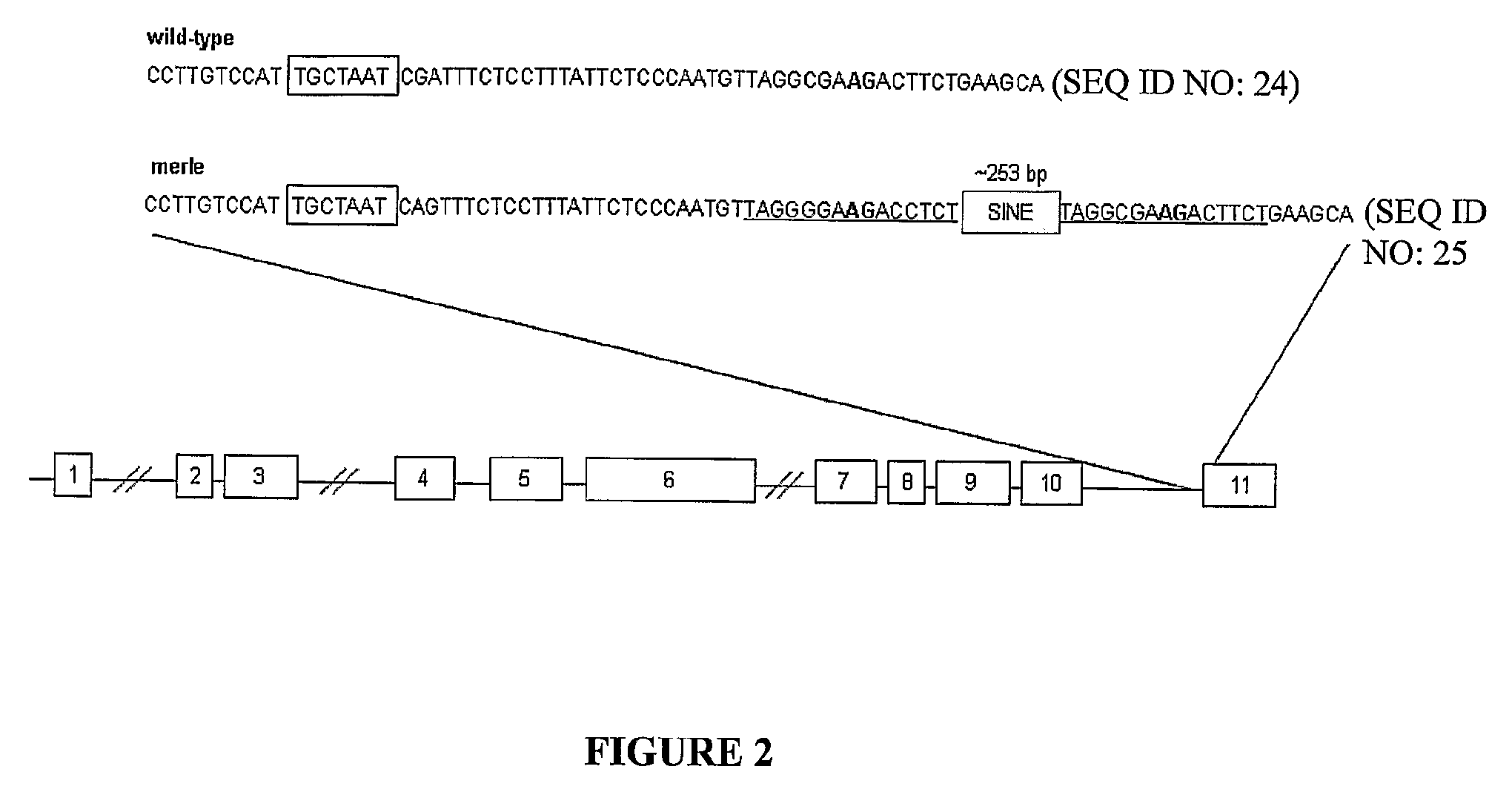Methods for identification of merle gene
a gene and gene technology, applied in the field of gene testing in dogs, can solve problems such as abnormal mrna
- Summary
- Abstract
- Description
- Claims
- Application Information
AI Technical Summary
Benefits of technology
Problems solved by technology
Method used
Image
Examples
example 1
Screening for Merle Gene
[0086]Materials and Methods
[0087]Sample collection. DNA samples were obtained from previous studies conducted in the Canine Genetics Laboratory at Texas A&M University and through contributions from participating owners and breeders. Whole blood or buccal cells were collected from all dogs and genomic DNA was isolated using the Puregene DNA Isolation Kit (Gentra Systems, Minneapolis, Minn., USA).
[0088]Genotyping. Fluorescently labeled primers were synthesized and multiplex PCR was performed for MSS-2 markers as described in Clark et al. (2004). PCR products were resolved with an internal size standard (GeneScan 500 LIZ, PE Biosystems, Foster City, Calif., USA) using an ABI 3730x1 DNA Analyzer (PE Biosystems). Genotypes were determined using Genemapper® Software v3.5 (PE Biosystems).
[0089]Linkage analysis. Analyses for LD were carried out for all genotyped MSS-2 markers using 41 Shetland sheepdogs. For each marker, the allele more often associated with the mer...
example 2
Determination of Breed Specificity of Merle Gene
[0098]To determine if the SILV mutation causing merle patterning in the Shetland sheepdog population was breed specific, merle and nonmerle dogs representing six other breeds (collie, Australian shepherd, dachshund, Cardigan Welsh Corgi, border collie, and great dane) were analyzed for the insertion. Merle dogs from all other breeds were heterozygous for the insertion (FIG. 4).
[0099]Eleven harlequin great danes were also analyzed: 9 were heterozygous and 2 were homozygous for the insertion. Sequence analysis revealed that dogs from the aforementioned breeds harbored the same SINE insertion in intron 10. An additional 29 dogs representing 26 breeds that do not have merle coloration were analyzed and did not harbor the insertion.
[0100]Summary of Results
[0101]60 Shetland sheepdogs used in the linkage study were analyzed for the insertion, which segregated perfectly with the merle phenotype. The insertion also segregated with merle among d...
PUM
| Property | Measurement | Unit |
|---|---|---|
| temperature | aaaaa | aaaaa |
| temperature | aaaaa | aaaaa |
| length | aaaaa | aaaaa |
Abstract
Description
Claims
Application Information
 Login to View More
Login to View More - R&D
- Intellectual Property
- Life Sciences
- Materials
- Tech Scout
- Unparalleled Data Quality
- Higher Quality Content
- 60% Fewer Hallucinations
Browse by: Latest US Patents, China's latest patents, Technical Efficacy Thesaurus, Application Domain, Technology Topic, Popular Technical Reports.
© 2025 PatSnap. All rights reserved.Legal|Privacy policy|Modern Slavery Act Transparency Statement|Sitemap|About US| Contact US: help@patsnap.com



